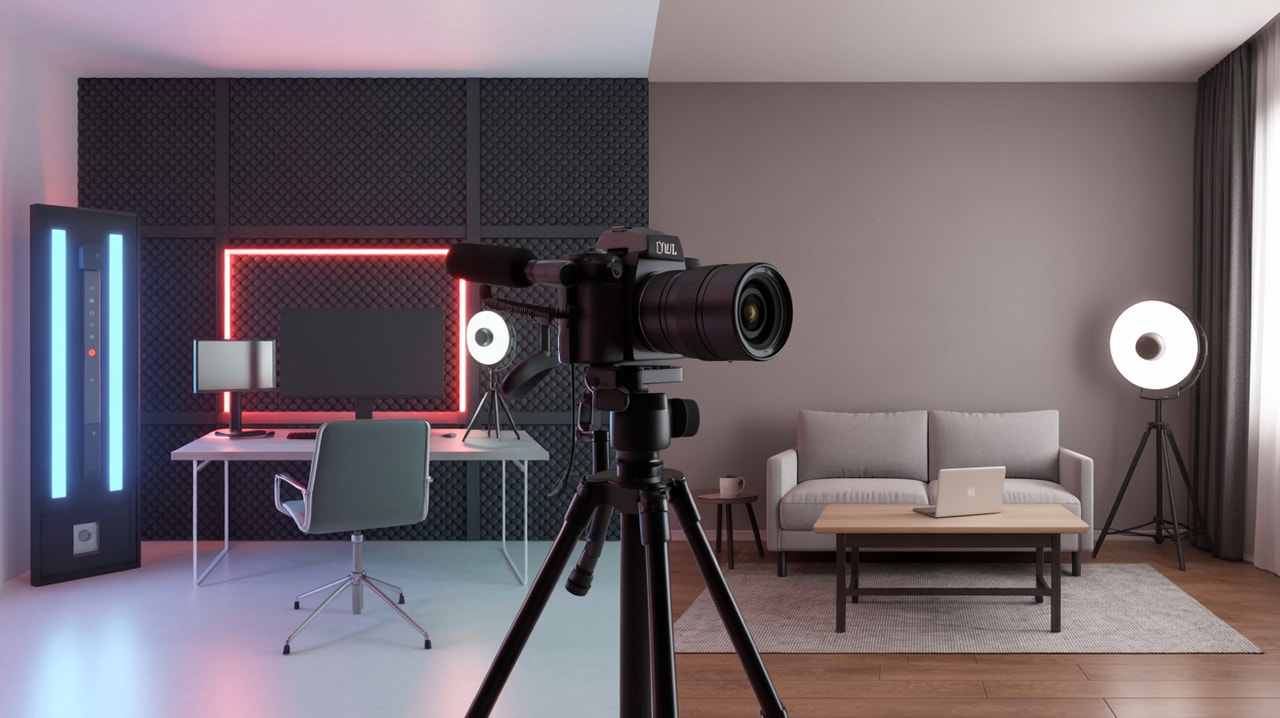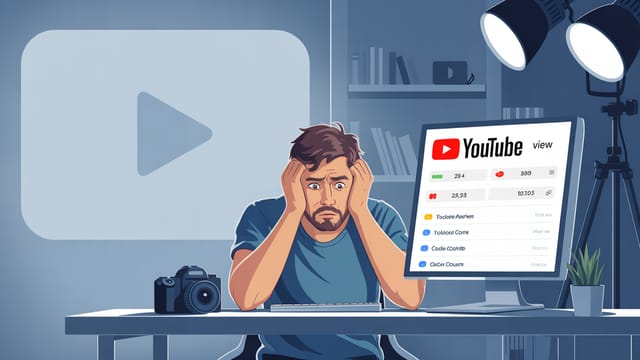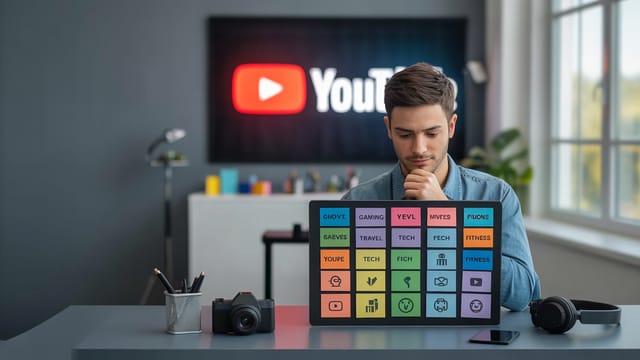
Ready to get your next 10,000 subscribers?
Join thousands of creators who use Subscribr to create faster, better YouTube videos.
Do I Need a Dedicated Filming Room for YouTube? (Pros & Cons)
Creating consistent, high-quality YouTube content can feel like a constant battle against technical hurdles. Many creators struggle with finding a reliable space, dealing with distracting backgrounds, inconsistent lighting, and the perpetual setup and teardown of equipment. This often leads to wasted time, creative frustration, and ultimately, slower channel growth.
One solution many creators consider is establishing a dedicated filming room or studio space. But is it truly necessary? Or can you achieve the same results with a more flexible approach? This article explores the pros and cons of having a dedicated YouTube filming room to help intermediate-level creators make the strategic decision that's right for their channel.
Overcoming Equipment Limitations and Space Constraints
One of the biggest pain points for creators is the feeling of being limited by their current filming environment. Maybe you're constantly clearing dining tables, moving furniture, or trying to find a corner of your bedroom that looks presentable on camera. This lack of a consistent space can make achieving a professional look and feel incredibly challenging.
A dedicated filming room directly addresses the pain point of space constraints. It provides a permanent home for your gear, eliminating the need for daily setup and teardown. This not only saves significant time but also reduces the friction between having a video idea and actually hitting record. As highlighted in a Think Media podcast, systematizing your filming setup, such as keeping cameras on swivel arms or microphones on dedicated stands, makes it much easier to create content consistently.
However, the need for a dedicated space is often tied to the fear of equipment limitations. Creators may believe they need a sprawling studio filled with expensive gear to produce quality videos. This isn't necessarily true. While a dedicated space can certainly optimize the use of equipment, you can achieve excellent results even in a smaller, multi-purpose area with smart gear choices and a systematic approach.
The Time Sink of Setup and Teardown
Beyond space, the sheer amount of time spent setting up and tearing down equipment is a major drain on a creator's time and energy. This is time that could be spent on scriptwriting, editing, or engaging with your audience. For growth-focused creators, maximizing time spent on content creation is paramount.
A dedicated room solves this by allowing you to keep your camera, lighting, and audio equipment permanently in place. This "always-ready" state drastically reduces the time needed to start filming. Think Media also emphasizes the importance of preparing your filming environment in advance and having equipment easily accessible. This might mean designating a specific corner of a room or having a rolling cart for your gear if a dedicated room isn't an option.
For example, channels like @TechWithTim (1.77M subscribers) likely benefit from a highly organized and possibly dedicated space given their consistent output and production quality in tech tutorials. While we don't have specific details on their setup, the professionalism suggests a streamlined workflow where equipment is always ready.
Achieving Consistent Audio and Visual Quality
Inconsistency in audio and visual quality is a common issue for creators filming in different locations or with temporary setups. Background noise, fluctuating lighting, and varied camera angles can make your videos feel less professional and can be jarring for viewers.
A dedicated filming room provides a controlled environment where you can minimize these variables. You can implement sound treatment (like acoustic panels), set up permanent lighting that is always consistent, and establish fixed camera positions. This leads to a polished and reliable look and sound across all your videos, which is crucial for building a professional brand on YouTube.
Analyzing successful channels often reveals a high degree of consistency in their production. Look at channels like @TechRun (367K subscribers) or @atitecnology (185K subscribers) in the tech tutorial space; their videos generally maintain a consistent visual style and audio quality, suggesting a controlled filming environment, whether it's a dedicated room or a carefully optimized temporary space.
Advantages of a Dedicated Recording Space
Let's break down the specific advantages of having a dedicated filming room:
- Consistency: This is perhaps the biggest benefit. A dedicated space allows for consistent lighting, audio, background, and camera angles, leading to a more professional and branded look across all your videos.
- Efficiency: Eliminating setup and teardown saves significant time and energy, freeing you up to focus on content creation and strategy.
- Organization: A dedicated room provides a place to store all your equipment, keeping your living space tidy and your gear protected.
- Control: You have greater control over your environment, allowing you to minimize distractions, control lighting conditions, and improve audio quality through sound treatment.
- Professionalism: A consistent and controlled filming environment contributes to a higher perceived production value, which can enhance your channel's credibility and attract more viewers.
Can I Use My Bedroom as a YouTube Studio?
Absolutely! While a dedicated room is ideal for some, it's not a prerequisite for success. Many incredibly successful creators started and continue to film in multi-purpose spaces like bedrooms, living rooms, or home offices. The key is optimizing the space you have.
Think Media has a video titled "AMAZING YouTube Studio Setup Ideas for SMALL Spaces (Home Office Tour)" which specifically addresses how to create effective filming setups in limited areas. This highlights that with smart planning and equipment choices, you can transform almost any space into a functional filming area.
Using a bedroom or other multi-purpose room requires careful planning to minimize distractions and optimize your setup for quick transitions. This might involve:
- Using collapsible backdrops
- Investing in portable lighting
- Setting up a designated corner that can be quickly converted for filming
- Implementing temporary sound treatment like blankets or moving furniture
The video "My DREAM Youtube Setup Tour 2024⚡" by @Nikhil Pawar (107K views) and "MY NEW YOUTUBE STUDIO SETUP REVEALED" by @Rachit Singh (175K views) showcase how creators have built functional studios, with Rachit Singh's title specifically mentioning a "NEW YOUUTBE BEDROOM STUDIO TOUR," proving that bedrooms can indeed be transformed into effective filming spaces.
How Much Space Do I Need for a YouTube Studio?
The amount of space you need depends entirely on the type of content you create and your filming style. You don't necessarily need a large room.
- Talking Head Videos: For videos where you are primarily seated and talking to the camera, a small corner of a room with enough space for you, your camera, lighting, and a background is sufficient.
- Demonstration Videos: If your content involves demonstrating products or actions (like cooking, art tutorials, or tech reviews), you'll need enough space for your workspace and to position the camera to capture the action clearly.
- Movement-Based Content: For fitness, dance, or other content requiring significant movement, you'll need a larger open area.
Even small spaces can be optimized. Consider using vertical space for storage, multi-functional furniture, and creative camera placement to make the most of limited square footage. The Think Media strategy suggestion about a creator using a soundproof room with a whiteboard carved out of a larger space demonstrates how even within a dedicated area, you can optimize for specific content needs.
Building a Versatile YouTube Studio: Dedicated vs. Flexible Approaches
The decision between a dedicated filming room and a more flexible setup boils down to your specific needs, resources, and content strategy.
Dedicated Filming Room (Pros):
- Maximum consistency and control over environment.
- Most efficient for creators who film frequently.
- Professional appearance is easier to achieve and maintain.
- Equipment can remain set up, reducing friction.
Dedicated Filming Room (Cons):
- Requires a dedicated physical space.
- Can be more expensive to set up initially (sound treatment, permanent lighting fixtures).
- Less flexibility if you need to film in different locations.
Flexible Filming Setup (Pros):
- Utilizes existing space, no need for a dedicated room.
- More cost-effective to start.
- Greater flexibility to film in various locations.
Flexible Filming Setup (Cons):
- Requires more time for setup and teardown before each shoot.
- More challenging to achieve perfect consistency in lighting and audio.
- Requires efficient storage solutions for equipment.
Ultimately, the "best" approach is the one that allows you to consistently create high-quality content without burning out. For intermediate creators looking to grow, consistency and efficiency are key. If a dedicated space helps you achieve that, it's a worthwhile investment. If you can maintain consistency and efficiency with a flexible setup, that's perfectly valid too.
Tools like Subscribr can help you analyze your channel's performance and understand what level of production quality resonates with your audience. By using features like Channel Intelligence and Video Intel, you can see how viewers are responding to your current setup and identify areas for improvement, informing your decision about your filming environment.
Workflow Efficiency Through Equipment and Design
Regardless of whether you choose a dedicated room or a flexible setup, optimizing your workflow through smart equipment choices and thoughtful design is crucial.
- Equipment that Stays Set Up: Invest in stands, mounts, and arms that allow you to keep your camera, lights, and microphone in position, even in a multi-purpose room.
- Quick-Release Plates and Mounts: For flexible setups, use quick-release systems on your tripod and light stands to make setup and teardown faster.
- Organized Storage: Have a designated area or storage solution for all your gear so you can quickly find what you need.
- Lighting Solutions: Consider permanent lighting fixtures in a dedicated room or easy-to-set-up portable lights for flexible spaces. Ring lights, softboxes, and LED panels can drastically improve visual quality.
- Audio Treatment: In a dedicated room, consider acoustic panels. In a flexible space, use blankets, pillows, or even record in a closet to minimize echoes and background noise.
The "This All-In-One YouTube Studio Setup Rocks!" video by Think Media (290K views) demonstrates how a mobile studio setup can create workflow efficiency. This type of setup, while not a dedicated room, provides a high degree of readiness and organization.
Making Strategic Decisions for Your Channel
Deciding whether to invest in a dedicated filming room is a strategic decision that should align with your channel's goals and resources. Consider:
- Your Content Type: Does your content require a specific environment or setup?
- Your Filming Frequency: How often do you plan to film? The more frequent, the more a dedicated space benefits efficiency.
- Your Budget: Can you afford the cost of potentially renting a larger space or investing in significant sound treatment and permanent fixtures?
- Your Living Situation: Do you have the available space for a dedicated room?
Ultimately, the goal is to create a filming environment that supports your content creation process, reduces friction, and allows you to consistently produce high-quality videos that engage your audience. Whether that's a fully dedicated studio or a cleverly optimized corner of your home, the right setup is the one that empowers you to create your best work.
Subscribr's tools can help you make these strategic decisions by providing data on what resonates with your audience and streamlining your overall content workflow, allowing you to focus on creating compelling videos regardless of your filming environment.
Conclusion
A dedicated filming room for YouTube offers significant advantages in terms of consistency, efficiency, and control, directly addressing common pain points like equipment limitations, setup time, and inconsistent quality. However, it is not the only path to success. Many creators thrive with flexible setups in multi-purpose spaces by focusing on smart equipment choices, workflow optimization, and maximizing the potential of their existing environment.
The decision depends on your individual circumstances, content needs, and growth goals. By carefully weighing the pros and cons and considering how different setups impact your workflow and the quality of your output, you can make an informed decision that sets you up for sustained success on YouTube. Remember, the most important factor is creating a system that allows you to consistently produce valuable content for your audience.





